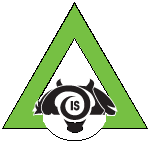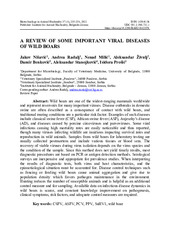Приказ основних података о документу
A REVIEW OF SOME IMPORTANT VIRAL DISEASES OF WILD BOARS
| dc.creator | Nišavić, Jakov | |
| dc.creator | Radalj, Andrea | |
| dc.creator | Milić, Nenad | |
| dc.creator | Živulj, Aleksandar | |
| dc.creator | Benković, Damir | |
| dc.creator | Stanojković, Aleksandar | |
| dc.creator | Prošić, Isidora | |
| dc.date.accessioned | 2023-12-15T07:00:14Z | |
| dc.date.available | 2023-12-15T07:00:14Z | |
| dc.date.issued | 2021-12-30 | |
| dc.identifier.issn | 1450-9156 | |
| dc.identifier.uri | http://r.istocar.bg.ac.rs/handle/123456789/969 | |
| dc.description.abstract | Wild boars are one of the widest-ranging mammals worldwide and represent reservoirs for many important viruses. Disease outbreaks in domestic swine are often described as a consequence of contact with wild boars, and traditional rearing conditions are a particular risk factor. Examples of such diseases include classical swine fever (CSF), African swine fever (ASF), Aujeszky’s disease (AD), and diseases caused by porcine circoviruses and parvoviruses. Some viral infections causing high mortality rates are easily noticeable and thus reported, though many viruses infecting wildlife are insidious impacting survival rates and reproduction in wild animals. Samples from wild boars for laboratory testing are usually collected postmortem and include various tissues or blood sera. The recovery of viable viruses during virus isolation depends on the virus species and the condition of the sample. Since this method does not yield timely results, most diagnostic procedures are based on PCR or antigen detection methods. Serological surveys are inexpensive and appropriate for prevalence studies. When interpreting the results of diagnostic tests, both virus and host characteristics, and the epizootiological situation must be accounted for. Disease control techniques such as fencing or feeding wild boars cause animal aggregation and give rise to population density which favors pathogen maintenance in the environment. Hunting reduces the number of susceptible animals and is helpful as an additional control measure and for sampling. Available data on infectious disease dynamics in wild boars is scarce, and constant knowledge improvement on pathogenesis, clinical symptoms, risk factors, and adequate control measures are required. | sr |
| dc.language.iso | en | sr |
| dc.publisher | Institut za stočarstvo, Beograd-Zemun | sr |
| dc.relation | info:eu-repo/grantAgreement/MESTD/inst-2020/200143/RS// | sr |
| dc.rights | openAccess | sr |
| dc.rights.uri | https://creativecommons.org/licenses/by/4.0/ | |
| dc.source | Biotechnology in Animal Husbandry | sr |
| dc.subject | CSFV | sr |
| dc.subject | ASFV | sr |
| dc.subject | PCV | sr |
| dc.subject | PPV | sr |
| dc.subject | SuHV1 | sr |
| dc.subject | wild boar | sr |
| dc.title | A REVIEW OF SOME IMPORTANT VIRAL DISEASES OF WILD BOARS | sr |
| dc.type | article | sr |
| dc.rights.license | BY | sr |
| dc.citation.volume | 37 | |
| dc.citation.issue | 4 | |
| dc.citation.spage | 235 | |
| dc.citation.epage | 254 | |
| dc.identifier.doi | 10.2298/BAH2104235N | |
| dc.identifier.fulltext | http://r.istocar.bg.ac.rs/bitstream/id/4561/bitstream_4561.pdf | |
| dc.type.version | publishedVersion | sr |


